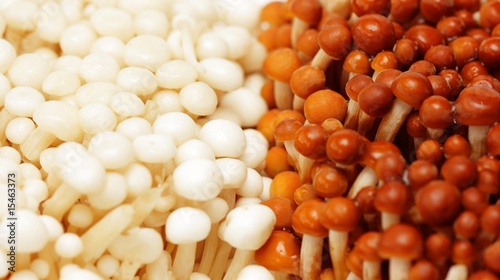Enoki Mushrooms Recipes
Here's a look at the different types of edible mushrooms used in various recipes. Learn more and see pictures of the different fungi. Delicious, easy-to-follow vegetarian recipes. Preparation: 20 minutes. Other Mains: Peter Singer's Red Lentil Dahl Mushroom and Lentil Shepherds Pie.

Horse Mushrooms – Edibility, Identification, Distribution June 26, 2012. Agaricus arvensis. Also The Prince (agaricus augustus), Macro-Mushroom (agaricus urinescans. I knew Enoki mushrooms had finally made it to the mainstream in the US when our vegan friend, Mitch, (you can see him in the camping photos with Bill), claimed that. 12 slices of bacon, halved crosswise Two 4-ounce packages enoki mushrooms, trimmed and split into 24 bundles 3 scallions, quartered lengthwise and cut into 3-inch.
Cool Vegan Recipes Made with Mushrooms. Happy Day of the Mushroom! Today, celebrate the diverse types of edible mushrooms there are: portobello, white button, cremini, oyster, shiitake, enoki, and porcini, to name a few. Prior to the 1. 94. The most common variety for purchase were brown cremini mushrooms. Mushrooms offer texture to vegan and vegetarian dishes, giving them a hearty and “meaty” taste and appearance.
They are loaded with vitamins and minerals and are also a great diet food, because they retain lots of water and fiber. Did you know? Mushrooms outrank bananas in potassium content!
Mushrooms are also the only good source of Vitamin D in the produce section, and they provide B vitamins. And a recent study shows that shiitake mushrooms can help prevent cervical cancer! There’s even a new “mushroom death suit” that’s hit headlines, stating that the “suit” is a great, natural way to move on when you “kick the bucket.” Enjoy a mushroom- stuffed dish or a stuffed mushroom dish today!
Horse Mushrooms – Edibility, Identification, Distribution – Galloway Wild Foods. June 2. 6, 2. 01. Agaricus arvensis. Also The Prince (agaricus augustus), Macro- Mushroom (agaricus urinescans) and Field Mushroom (agaricus campestris)Horse Mushrooms (agaricus arvensis)Edibility – 4/5.
Identification – 3/5 – beware of yellow stainer (agaricus xanthodermus) – see below for full details. Distribution – 3/5 – These once abundant mushrooms are becoming less common due to habitat loss. Season – June to December. Habitat – fertile pastures (without artificial fertilisers), verges, hedgerows, wood edges.
A horse mushroom in its prime is a thing of great beauty and superb flavour. It also has the curious dual distinction of being commonly misidentified and widely underrated. On the one hand it is pounced upon as a “proper mushroom” by the non- fungi literate because it resembles its tamed relatives (mostly derivations of agaricus bisporus), blisfully ignorant that the poisonous yellow stainer (agaricus xanthodermus) is virtually identical (at least until eaten). On the other hand horse mushrooms tend to be overlooked by wild mushroom aficionados in favour of their weird and wonderful woodland cousins. How often do you see horse mushrooms on a menu compared to chanterelles, ceps or even vile “pretend” wild mushrooms like enoki? A fine pair of horse mushrooms.
I have touched before upon the dangers of making assumptions about mushrooms based on their general appearance rather than precise mycological characteristics (see “Mushrooms v Toadstools”) and nothing illustrates the point better than horse mushrooms and yellow stainers. The rule is quite simple: If the base of the stipe turns chrome yellow when bruised, don’t eat it.
Quite a simple test for the mushroom world really, yet hundreds of people still get sore tummies every year from eating the really quite helpfully named yellow stainer. These are often people who wouldn’t dream of eating less conventional looking woodland mushrooms and feel comforted by the illusion of familiarity. Yellow stainer (agaricus xanthodermus) showing chrome- yellow staining when bruised at base.
The idea of people stravaiging about the countryside grabbing any fungi that reminds them of what they see in the shops becomes rather more worrying when you consider that death caps can lurk in the same hedgerows and field edges as horse mushrooms. While the yellow stainer could put you in the loo for a few hours, the death cap could put you in a box for considerably longer…The lethal Death Cap mushroom (amanita phalloides)That’s enough scaremongering for one post. It is always best to focus on positively identifying a species rather than over- dwelling on things it might be – if you can tick off the identification points for young and old specimens in these two pictures you have very little to worry about. And if you aren’t sure…NEVER MUNCH ON A HUNCH! Horse mushroom identification features (unopened caps)Horse mushroom identification (mature)The pink gilled caps of young horse mushrooms have a sweetly fragrant aniseed aroma that I rate nearly as highly as prime ceps, and certainly in my top table of gourmet wild mushrooms. The texture can be a wonderfully rare combination of light, crisp and succulent.
This is truly a gastronomes mushroom and it is, paradoxically, only its physical similarity to cultivated mushroom that keeps it out of top kitchens. Young caps, simply sliced, seasoned, dressed with a light oil and lemon juice and served with wood sorrel, sweet cicely (which echoes the aniseed aromas – see recipe here) and a few shavings of parmesan, is one of the finest mushrooms dishes you can eat. Older specimens will have lost some pizzazz, but make up for that in size and meatiness (just like humans really). They are still the makings of epic breakfasts and the finest soups though. Horse mushrooms are still relatively common despite being generally on the decline due to habitat loss.
They earned their name due to a liking for generously (horse) manured fields. They are just one of many excellent wild mushrooms (waxcaps, field mushrooms, parasols etc) that thrived among the convivial husbandry of yore but are dwindling amid the industial- chemical agro- business of today. The phosphate- heavy fertilisers and fossil- fuel based practices that many farmers use to grow unnaturally green silage generally inhibit mycorrhizal activity – a bit of an expensive (financial and environmental) own- goal when you consider that many of these fungi actually stimulate plant growth.
Such is the pressure on natural grassland, there is the very real prospect of the once prolific field mushroom (agaricus campestris) going off the wild food menu altogether in some areas of the UK. Fortunately, the superior and more substantial horse mushroom is a little more versatile in its choice of habitats: I find most of mine in wood edges and hedgerows, often growing in “family groups” and rings that can make for a good harvest of young and mature caps, and still leave plenty behind to perpetuate the colony. Please read and share this on sustainable mushroom picking.
Sometimes horse mushroom rings can be 1. Welsh border (NB: It isn’t a sheep formation dance troop!): If, like me, you find many of your horse mushrooms on roadside verges, you should be aware of their capacity to absorb and concentrate heavy metals – notably cadmium and copper.
While there is some doubt how much of these are actually absorbed through the gut wall, it isn’t a good idea eat too many picked from busy roadsides, but I am comfortable with a handful a year from our quiet Galloway lanes. Incidentally, the ability of fungi to absorb both ground and airborne toxins is a hot field of research at the moment: check this out and this fantastic insight by fungi- guru Paul Stamets.
Then order this – it will blow your mind!! There are at least 4.
UK – and countless other cultivated strains growing in darkened chambers. Some of the wild cousins are well worth keeping your eye out for: – Macro mushroom (a. Cogwheel’ less pronounced, base of stem has wooly scales, smells of aniseed – not quite so good to eat, though still excellent if eaten soon after picking. Huuuuge macro mushrooms– The Prince – (a. This should rightfully be declared King of the Agarics as it is the tastiest of the lot, with sweet almond nuances floating above the aniseed and mushroom aromas. It is also enigmatic in when and where it chooses to appear – beneath conifers seem to be its preferred throne.
Cap up to 2. 5cm, cream with brown scales, club shaped stipe with brown tipped shaggy fibres when young, gills white then brown then chocolate. Sublime.– Field mushrooms – (a. Apply the standard tests for yellow stainer and harvest sensitively.
Field mushrooms (and other mushrooms to a lesser extent) appear to enjoy a ‘bumper year’ at 7 year intervals – though this may coincide with ideal growing conditions. Benihana Onion Soup Recipe on this page. Or witchcraft. Know them by the overhanging skin of the cap, narrowing stipes, simple fragile rings, and faintly blushing flesh. Field mushrooms. Related Pages.
